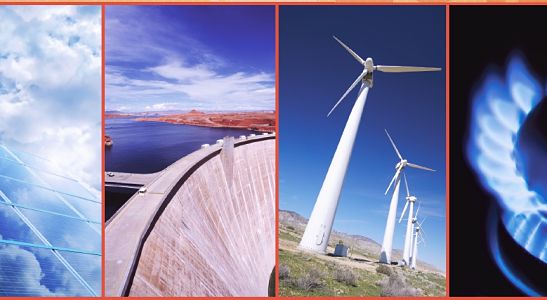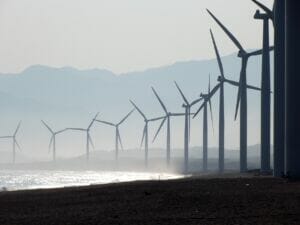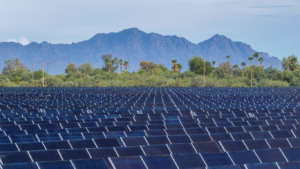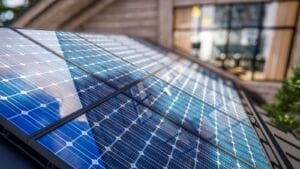The Arizona Energy Consortium is creating an Energy Roadmap to complement Arizona’s existing energy sources and bolster the state’s renewable sector, which stretches from solar and wind power producers to energy-efficiency companies.
Think about being a placekicker and each time you line up to attempt a game-winning field goal, the goal posts shift.
That’s how Chris Davey, executive director of EnviroMission, an Australian firm with plans to build a 2,800-foot solar energy tower in western Arizona, describes what it can be like to do business as a developer of energy projects in Arizona.
“If you’ve got one regulatory body that you answer to and it changes midway through the process, it’s going to impact how you develop a project,” Davey says. “If you’ve got various government agencies that are meant to respond within a certain period of time and they take five times as long to do that, it creates uncertainty. It changes timelines and constantly moves the end zone.”
To help ease some of the uncertainty in Arizona’s energy industry, Davey has teamed up with Michelle De Blasi, a partner with Quarles & Brady who focuses her practice on guiding renewable energy projects from concept to completion, to co-chair the Arizona Energy Consortium (AEC).
“The AEC initiatives aren’t an academic exercise,” Davey says. “The AEC is not driven by the utilities, nor academics, nor regulators. It’s driven by industry and what’s best to ensure Arizona has a diverse energy future that maintains reliability and cost effectiveness.”
The AEC — a committee of the Arizona Technology Council (AZTC) — was created to become a member-driven voice for Arizona’s growing energy industry.
“We don’t have an energy plan,” De Blasi says. “We don’t have one nationally and we certainly don’t have one in the state. There are bits and pieces of a plan going on at any given time, but we don’t have a plan that guides us. Without that plan, it’s very difficult for Arizona to compete with other states that have much more clarity in their policies and incentives.”
BORN OUT OF A NEED
 The AEC’s broad cross sections of members — which include private, for profit and nonprofit companies; government and tribal organizations; and businesses that range in specialties from solar to title companies — show that there is a relatively unified belief that the state has to do something to become more competitive and friendly to the energy sector. And the AEC’s rapid growth — it has grown from about 40 members to more than 200 in less than six months — shows that the belief is strong.
The AEC’s broad cross sections of members — which include private, for profit and nonprofit companies; government and tribal organizations; and businesses that range in specialties from solar to title companies — show that there is a relatively unified belief that the state has to do something to become more competitive and friendly to the energy sector. And the AEC’s rapid growth — it has grown from about 40 members to more than 200 in less than six months — shows that the belief is strong.
“The AEC was born out of a necessity, from a true need for a platform for all affected stakeholders to come together and try to drive change, influence change and ultimately have an energy policy or roadmap in place that gets implemented and provides a fair playing surface,” Davey says. “We need a plan that says, ‘Here are the boundaries, you might be a little off on the left or on the right, but you need to know that you are still within those boundaries.’ As a developer, we have to know where the goal posts are.”
Part of establishing those boundaries is getting legislators, business owners and regulators on the same page.
Government policy has enormous impact on business, says Margaret LaBianca, a shareholder with Polsinelli Shughart, who counsels clients on a broad range of regulatory compliance and strategic considerations with respect to renewable energy. AEC pulls from all realms of the energy industry, which provides a broad view of the real-life implications of legal constraints and incentives. The upshot will be an ability to identify policies that best position Arizona’s energy industry for the long term.
What makes the AEC different from other energy groups in the state is that it is a statewide collaborative — members can sit in on meeting via video conferencing or by phone from anywhere in the world — that is applying its collective expertise to develop a long term strategic plan for energy industry growth. Also, the group isn’t focused on one energy sector. Fossil fuels, nuclear energy, natural gas and renewable energy are all treated the same and viewed from a big-picture perspective.
“This is probably strange because here I am pursuing a high-profile solar project and I’m the biggest advocate for energy diversity,” Davey says. “The AEC isn’t just another green initiative. It’s about energy and creating a diverse energy portfolio. Diversity is good for business.”
THE BUSINESS OF ENERGY
 The AEC’s mission is to promote economic development initiatives and technological innovations across the state, organizers say. To accomplish that, the AEC works with other Arizona organizations, including the Arizona Governor’s Energy Office, GPEC, elected officials, the Arizona Corporation Commission, Arizona tribes, Arizona utilities and local governments.
The AEC’s mission is to promote economic development initiatives and technological innovations across the state, organizers say. To accomplish that, the AEC works with other Arizona organizations, including the Arizona Governor’s Energy Office, GPEC, elected officials, the Arizona Corporation Commission, Arizona tribes, Arizona utilities and local governments.
Despite all the hard work completed by a number of Arizona stakeholders — from the governor’s office to GPEC — it is difficult for the industry to prosper while policies are unclear.
“It’s almost a daily call I get from people saying, ‘Hey, I’d like to set up my business there. What are your policies on this or that?’” De Blasi says. “I have to answer, ‘It’s not exactly clear.’ It’s frustrating for me and for potential businesses looking at Arizona, so sometimes they don’t come here. They go to California or New Mexico or Colorado where they have great policies.”
One fact that illustrates the problem: Phoenix-based De Blasi does more work with renewable energy in Massachusetts than she does in Arizona.
“If you look at the states that have been successful — California, Oregon, New Jersey, Massachusetts — it’s a wholesale buy-in,” De Blasi says. “It’s the governor. It’s the legislature. It’s the governing entity for their utilities. They go farther and have taken advantage of federal incentives to attract business.”
So why isn’t Arizona — with its 300 days of sunshine a year — a player?
“You’ve got your traditional power guys that are entrenched in the communities, they’ve been there forever because most power plants have been around a long time,” Davey says. “So you’ve got your fossil fuel technologies that have been around forever and then something new comes forward — whether that is solar, wind, geothermal, biomass — and it upsets the status quo. Most people want to see innovation happen, but they are scared to go down that path because it’s still relatively unknown.”
Not only is there a fear of the unknown, it’s the fear of higher production costs that keeps more energy innovation from happening.
“One of the defining challenges for the next decade and especially over the next century, will be to find an appropriate balance between the competing needs to supply electricity that is reliable, affordable and stays under an acceptable level of environmental impact,” says Mark Bonsall, general manager and CEO of Salt River Project (SRP). “One thing is clear – all the options are more expensive than our current portfolio of resources.”
LEGISLATIVE ROADBLOCKS
 For some lawmakers, the fear may lie in being more concerned with losing votes than on losing economic development for the state. “We have incredibly cheap power here,” De Blasi says.
For some lawmakers, the fear may lie in being more concerned with losing votes than on losing economic development for the state. “We have incredibly cheap power here,” De Blasi says.
“We have a nuclear power plant that supplies us with efficient and cheap energy. People are used to that. That has fed into legislators not wanting to be responsible for raising people’s energy rates by forcing the utilities to spend money replacing traditional energy with renewables.”
One of the AEC’s goals, De Blasi says, is to work with the legislators to help create legislation that promotes business.
“I would love for us to be a resource for the legislators to come to as a neutral body, with a pro-business mindset,” De Blasi says. “It would help tremendously if lawmakers reached out to the community and asked what they thought proposed legislation would do to industry and get community input before they put bills out onto the street that wreak havoc on the industry and wreak havoc on financing. By the time they have to pull them back or resend them, the damage is already done.”
Providing guidance and education for legislators will be the key to developing Arizona’s energy industry in the future, Davey says.
“We have to get lawmakers to support the right bills and educate them the right way so the right bills get written,” he stresses. “Instead of having something out there that provides a lot of uncertainty when you are trying to get a project delivered, we just want to provide a level of clarity that doesn’t necessarily remove a whole lot of due process; it just makes it clear so that when you’re developing something, you know what the next hurdle is going to be.”
It’s clear that Arizona legislators need to stop and listen to the needs of their constituents. According to a new poll from the Arizona Working Families Coalition, almost half of the likely voters surveyed said job creation — including those that would arise from changes in the energy sector — should be legislators’ top priority.
“It’s clear that voters want their legislators to stay out of working people’s financial decisions and to focus on the economy,” says John Loredo, who is working with Arizona Working Families and is the former Arizona House minority leader. “If lawmakers continue to ignore the priorities of the people who put them in office, there will be some real consequences for them in November.”
The first step toward removing some of those hurdles came in November 2011 when the AEC unveiled “Arizona’s Solar Strategic Plan,” a document that proposes recommended actions for the long-term growth of the state’s solar industry. The recommendations focused on technology innovation, manufacturing and power generation.
“The Strategic Plan is meant to guide Arizona’s growing solar industry along a sustainable path,” De Blasi says. “Our goals are increased jobs, economic development, energy self-sufficiency and security, technology innovation and reduced greenhouse gas emissions — all resulting from increased use of solar energy as a component of a broader energy strategy. The AEC will be working hard to pull together the stakeholders to ensure that the plan is implemented — the crucial step that has been missing with previous proposed plans.”
The plan’s recommendations include incentives — preferably back-end performance-based funds — to nurture existing solar companies and attract new firms; looking for ways to attract private investment; and longer-term utility incentives to spur demand, rather than the current year-to-year options.
“We’re in a conservative state and there is some resistance to renewable energy, but there is nothing better than taxing the sun,” Davey says. “If we think about it from a more broad perspective, where it’s not just about servicing Arizona’s needs, it’s about servicing our neighbor’s needs as well. If there is policy in place that adversely affects our ability to build here, it also affects our ability to generate energy that we could sell out of state, which is something everyone in the business community wants to achieve.”
De Blasi and Davey say the Strategic Plan will serve as a jumping off point for the AEC to develop a broader Energy Roadmap that will be a catalyst to attract new business and create a more friendly energy-industry environment.
“The end result will be not unlike the long-term Bioscience Roadmap initiated by the Flinn Foundation, designed to make the state’s life sciences sector globally competitive,” says Steven G. Zylstra, president and CEO of the Arizona Technology Council. “Arizona possesses many of the essential elements necessary to become a global leader in energy, but must strengthen its focus, collaboration and will to achieve this goal.”
THE ENERGY ROADMAP
 The AEC formed an Energy Roadmap subcommittee — led by De Blasi and Davey — to work with stakeholders and coordinate efforts that will further develop Arizona’s energy industry.
The AEC formed an Energy Roadmap subcommittee — led by De Blasi and Davey — to work with stakeholders and coordinate efforts that will further develop Arizona’s energy industry.
“There is the throwaway line that we want to be the Saudi Arabia of solar,” Davey says. “But right now, we are so far away from that, it doesn’t even matter.”
To ensure a competitive and secure economic future, De Blasi and Davey say the state must have a consensus-driven plan that will create a sustainable, safe, reliable, affordable, efficient, and diversified energy supply. Taking a page from the Bioscience Roadmap — which, since 2002, has helped Arizona increase the number of bioscience jobs by 41 percent and increase the state’s number of bioscience firms by 27 percent — De Blasi and Davey hope to design the Arizona Energy Roadmap, that will optimize Arizona’s unique assets, integrate regional investments and attract national and international interest as a place from which to conduct business.
“When you work in the energy industry every day, you realize the issues,” De Blasi says. “So to come up with a plan for the state, it’s just a matter of putting pen to paper and asking, ‘If I had my ultimate project or ultimate policies, what would that be? What are the stumbling blocks? What are the issues? What needs to be fixed and how do we go about fixing the problems?’”
The key issues that De Blasi and Davey say need to be addressed to make Arizona a more dynamic player in the energy industry are government policy and how it impacts the financing of energy projects; transmission of energy and how Arizona looks at transmission from both a statewide and regional perspective; and the state’s ability to use tax benefits to help different energy projects, something that has been difficult to make happen in Arizona, Davey says.
“It’s critical to change the message we send to potential developers — whether it’s the renewable energy industry or natural gas industry — and to stop pointing fingers and start working together and realize this is an energy mix,” De Blasi says. “Do we just want to be someone who gets all the crumbs from our neighboring states because that’s what we’ve gotten so far, or do we really want to be someone who leads and gets the benefit of the economic development and all the things that follow?”
To develop the content, identify issues, and generate feedback for the Roadmap, Davey and De Blasi are not turning to the usual suspects.
“They may not all be in the energy industry,” De Blasi says. “We want to talk with folks who have been in different industries, but have been successful in growing those industries. We want to pull in different ideas, different thoughts so that we can put together a comprehensive plan that we can implement successfully and will drive business.”
The most important thing the Energy Roadmap will do, Davey says, is create some clarity in an industry that has lacked clarity up until this point.
“Perception is reality,” Davey points out. “When you have a document — even if it’s not fully implemented yet — the perception will be that at least the state is moving in the right direction. It will be what helps differentiate us or at least put us on a level playing field with others who already have plans in place.”
De Blasi and Davey say they hope to have the Arizona Energy Roadmap drafted within the next couple months, although elements of the energy roadmap — such as the Solar Strategic Plan — may be released in stages. But once it’s released and implemented, Davey says it will send a message to developers like himself.
“It will say to the world, ‘Arizona is open for business,’” he says. “Once you provide clarity and certainty, money follows and projects get done. Once projects are done, there is job creation and a new diverse economy that comes from a supply chain. We will end up with different glass manufacturers, plastic manufacturers, steel manufacturers, aluminum manufacturers, and fabricators that are going to be here that aren’t here today. You’re going to have the best engineers here. Their kids are going to go to school here, so the education system will be impacted.
“Arizona has the land, the environment, the proximity to an incredible market, to not only put something in place to service our domestics market, but to service neighboring markets as well,” Davey says. “So if the Energy Roadmap is able to create an environment that creates that certainty and clarity so that business can prosper, that would be something pretty good to walk away from.”
For those individuals and companies who want to become a member of the AEC and are not already members of the Arizona Technology Council, the AZTC is waiving its membership requirement to participate in the AEC for 2012. For more information, contact Lauren Ferrigni at lferrigni@aztechcouncil.org.
For more information on the Arizona Energy Consortium and the Energy Roadmap, visit the Arizona Technical Council’s website at aztechcouncil.org/committees/aec.
Go to related article – Power Brokers Leading the Charge




